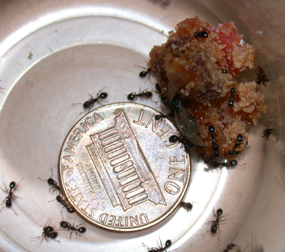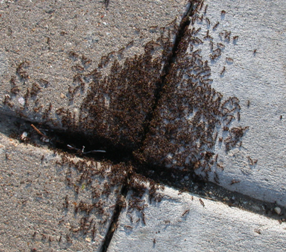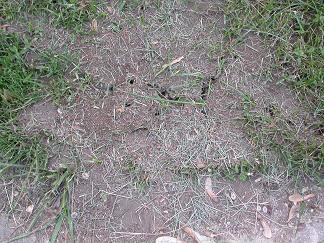
Rachel Arango, UW-Madison Entomology and Phil Pellitteri, UW Insect Diagnostic Lab
Revised: 1/27/2008
Item number: XHT1160
Background: Native to Europe, pavement ants were introduced into eastern North America in the 1700’s, and have become a common indoor problem in Wisconsin in recent years. Pavement ants feed on foods rich in proteins (e.g., meats, nuts, cheese), honey and other sweets, bread, grease, pet food and dead insects.
Pavement ants often nest outdoors in soil under stones, sidewalks and in building foundation cracks. Indoors, pavement ants can nest in wall voids, typically in areas of higher humidity and near a heat source (e.g., along hot water lines). Colonies of pavement ants can become quite large (3,000 to 4,000 individuals) with multiple queens. Winged forms of pavement ants (called swarmers) are usually found in spring. However, in indoor colonies, swarmers can be found anytime of the year.
Appearance: Pavement ants can be identified using the following characteristics:
• Adults have reddish-brown to black bodies with paler legs and antennae.
• Antennae are 12-segmented with a three-segmented club.
• Workers are about 3/16 inch (3½ mm) long.
• The thorax has a pair of small posterior spines.
• The petiole has two nodes.
• The head and thorax both have vertical, parallel grooves.
Control: Knowing what species of ant you have, as well as their habits, will help you find the nest and select proper baits or sprays. You will need to kill the queens to eliminate a colony. To find the nest, inspect foundation perimeters for outdoor colonies, and for lines of worker ants that are foraging for food. Track any foraging workers back to the nest.
Once a nest has been located, a variety of commercial ant sprays and dust formulations can be used for control. Chemicals may need to be drenched into the ground to penetrate deep enough to kill the queens. Dusts can also be used to treat nests in wall voids and other cavities. Treating along the outside foundation of a house as a barrier treatment will stop ants from coming indoors, but will not eliminate the nest, and problems may recur.
If a nest can not be located, ant baits should be used. Protein based baits, or protein and sugar mixes are most effective for control of pavement ants. Baits are available as gels, granules or as bait stations. Continue to use baits for as long as you see ant activity.
Additional Images
Download Article






 Field Ants
Field Ants Citronella Ants
Citronella Ants Deer Flies and Horse Flies
Deer Flies and Horse Flies Roseslug Sawfly
Roseslug Sawfly


